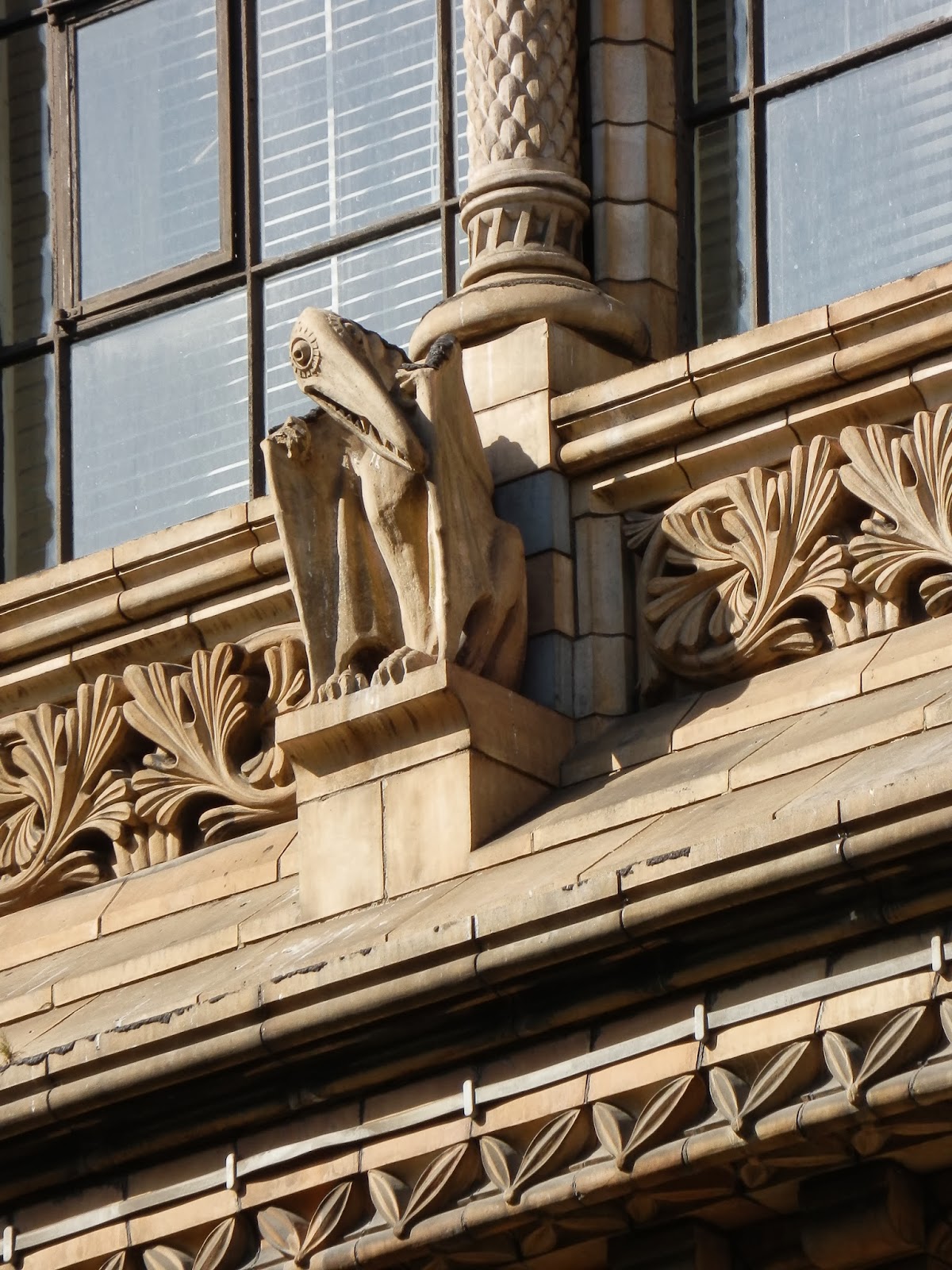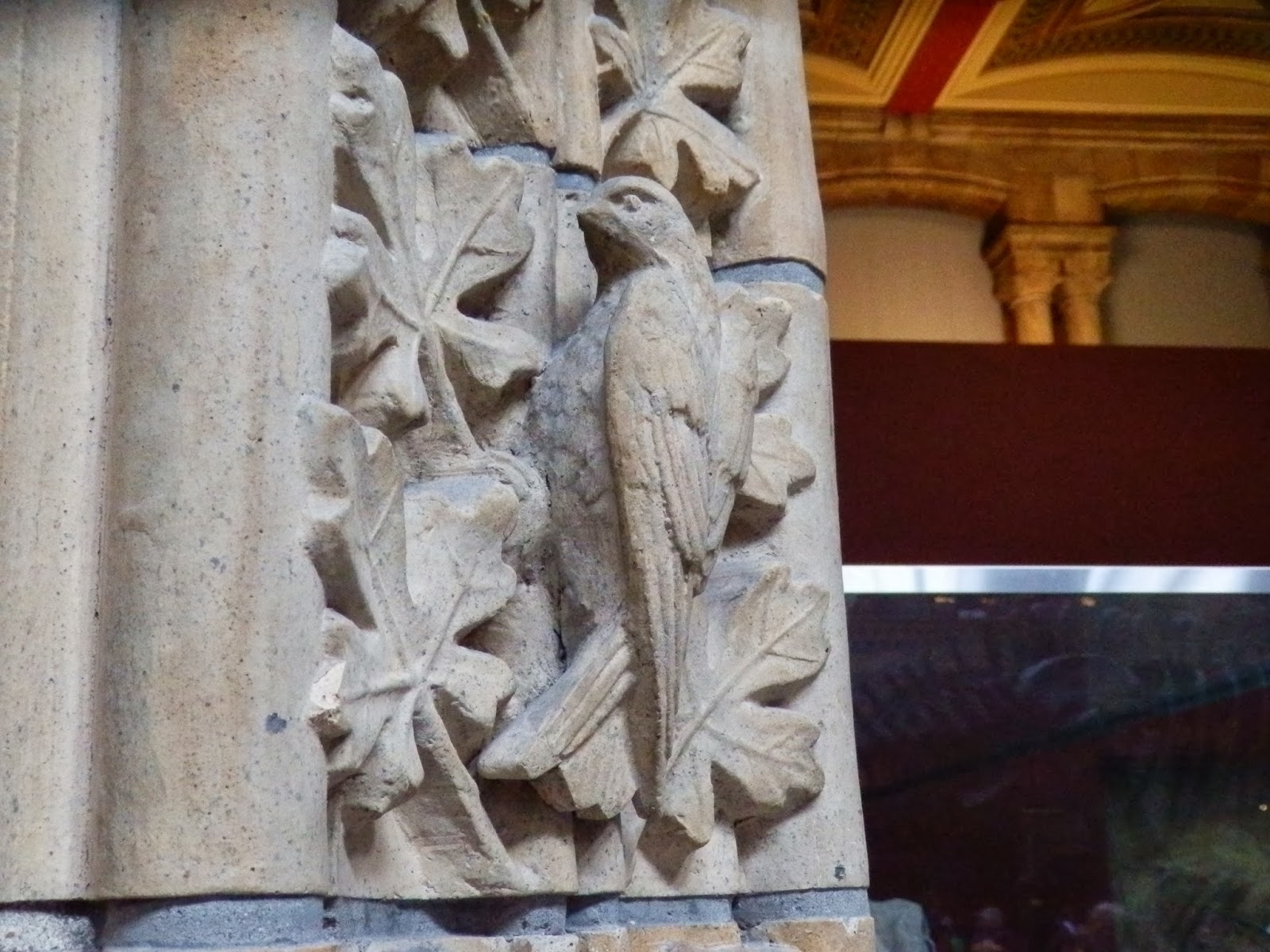I want to introduce you to one of the museums in London. A very specific one that occupies pride of place on Cromwell Road.
It's not the Victoria and Albert, London's exhibitor of historical fashion.
It's the other one.
The Natural History Museum.

I assure you, its not just anyone I drag to this museum, (one of) my favourites in London. Though I do ensure it takes its rightful place on the 'must see in London' lists of many of my family and friends. However the reason for this, is not the result of the museum's content alone. It is the building itself that holds my gaze the longest.
Years ago, my parents took my sister and I to London for a few days. We were each allowed one attraction to visit, and mine was the V&A. However one of my most enduring memories of that visit is not the interior of the fashion gallery in the V&A, but is instead of the grotesques standing sentry over the neighbouring museum. While we stood waiting, my father's camera was trained on one of the creatures on the skyline of the Natural History Museum. I remember it being a small and delicate feature, impossible to capture with my far more primitive lens, but Dad persisted, repeatedly zooming out and in until he could capture the creature to bear back to Australia. It is this memory which gives me such delight in grotesques and gargoyles, has resulted in the philosophy to 'always look up' and reminds me of the unending delight this museum can hold.
Living in London, I returned, and waiting in line, I got the chance to take a proper look at the building that had intrigued my father so many years ago.
It's not the Victoria and Albert, London's exhibitor of historical fashion.
It's the other one.
The Natural History Museum.

I assure you, its not just anyone I drag to this museum, (one of) my favourites in London. Though I do ensure it takes its rightful place on the 'must see in London' lists of many of my family and friends. However the reason for this, is not the result of the museum's content alone. It is the building itself that holds my gaze the longest.
Years ago, my parents took my sister and I to London for a few days. We were each allowed one attraction to visit, and mine was the V&A. However one of my most enduring memories of that visit is not the interior of the fashion gallery in the V&A, but is instead of the grotesques standing sentry over the neighbouring museum. While we stood waiting, my father's camera was trained on one of the creatures on the skyline of the Natural History Museum. I remember it being a small and delicate feature, impossible to capture with my far more primitive lens, but Dad persisted, repeatedly zooming out and in until he could capture the creature to bear back to Australia. It is this memory which gives me such delight in grotesques and gargoyles, has resulted in the philosophy to 'always look up' and reminds me of the unending delight this museum can hold.
Living in London, I returned, and waiting in line, I got the chance to take a proper look at the building that had intrigued my father so many years ago.


 It is easy to see that the building was purpose built, to house an ever-expanding collection of specimens from plants, animals and minerals, existing, extinct and fossilised.
It is easy to see that the building was purpose built, to house an ever-expanding collection of specimens from plants, animals and minerals, existing, extinct and fossilised.Each group is depicted somewhere upon the infrastructure of the building, in the form of grotesques, silhouettes, plaques and little creatures peering out at visitors from the protection of stone foliage.
Standing on the steps of the Cromwell Rd entrance, one starts to recognise the specimens on display. Richard Owen, superintendent of the collection at the time of this building's design, insisted that the building itself reflect the contents of the building, internally and externally, though it is perhaps surprising that they were separated into the extinct and the existing at a time when Darwin was demonstrating the connection between them.

To the west are those creatures still in existence while to the east are those specimens now extinct...


With the treasures to be seen on the front facade it is almost with disappointment that one is dragged inside, until it is realised that here too the architect had been at work, filling every feasible nook and cranny.
Around some archways monkeys scurry up a vertebrae...

Where columns exist, they rest upon a pair of Rams heads...
...and house lemurs or spooky owls in their upper reaches.
Gazing skywards, continue on further to the ceiling where flora specimens are displayed, on the panels of the ceiling and the metal rafters that hold up the roof.
Taking on a slightly different theme, the mineral room is decorated to create the impression of being under water. Around the base of each column prehistoric water flora is etched while above, amphibians glide through the rippling current.

When you're not too busy gaping at the architecture, the specimens are also worth a look-see. From the skeletons of monkeys swinging down the hall, to the 1300 year old sequoia tree...

...the cross-section of a tree spread out on the ceiling of one of the galleries to the galleries of stuffed animals (some of which are pulling funny faces).

I'm a cruel person I know, but I can't help thinking of this little fellow on a spit, basting over a low fire. Truthfully, most of what I did see in this museum (excluding the bug-less bug gallery) was delightful and very much a beginners guide to animals of the world. One feature looked at the mechanism of how a horse gallops and absorbs the pressures of its own weight against the solid ground. It was a beginners guide to the contents of the Channel 4 program Inside Nature's Giants. This documentary series explains the unique features of some of the bigger animals on the planet and how these features help it adapt its size to the environment in which it finds itself.
On the second occasion, we went to see Body Works, an exhibition by Gunter von Hagens, which plastinates animals before peeling away the skin to reveal their muscle placement or the intricate network of their blood vessels.

In terms of looking at the inner workings of an anatomical being this exhibition was a close second to the Inside Nature's Giants. Looking at these specimens it was incredible to see the sheer extent of the network of blood vessels in the head of a horse, stare into the eyes of an octopus or the nervous system of a house cat.
In a way it took me back to Human Biology when we were allowed the experience of dissecting a heart, a brain and a kidney and were able to see and feel for ourselves the more obvious differences that made up the components of the organ. This exhibition enabled you to visualise the detail in 3D, to see each and every one of the capillaries that transport blood, food and waste to and from each and every one of the cells in the body.
When we'd exhausted our awe within that exhibition we crossed the central court to the dinosaurs.
It's strange as this collection of dinosaurs, including ones that roar and growl menacingly, is renown and yet it was one of the few galleries of which I was not a fan. I prefer the dinosaurs I grew up with, in my own local museum (I know I'm just picky and like the memories of my own childhood). But I'm sure its the perfect place to start any child's obsession.
So, if you ask for somewhere to visit in London, don't be surprised if I send you here.


























No comments:
Post a Comment